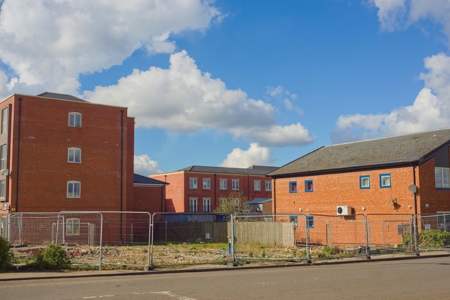In real estate and urban planning, the choice between Greenfield and Brownfield sites is a fundamental decision that shapes the trajectory of development projects. Whether you’re a developer, investor, or simply interested in the future of urban development, join us as we dissect the factors that make Greenfield vs. Brownfield sites distinct.
Table of Contents
What Are Greenfield and Brownfield Sites?
Before diving into the heart of the matter, defining what we mean by “Greenfield” and “Brownfield” sites is crucial. These terms represent two distinct pathways in development, each with unique characteristics and considerations. Here’s a table to help understand the difference between Greenfield vs. Brownfield sites.
| Criteria | Greenfield Sites | Brownfield Sites |
| Definition | Undeveloped areas, often agricultural or grassland, poised for new construction. | Previously developed lands that may be contaminated or have existing structures, often in urban settings. |
| Typical Location | Outside urban areas, in more rural or suburban settings. | Within or near urban areas where prior industrial or commercial activity occurred. |
| Development | Offers a clean slate for development with fewer existing constraints. | Involves adapting or rehabilitating existing structures or cleaning up contamination. |
| Challenges | Potential loss of natural habitats, biodiversity, and increased carbon footprint from new constructions. | May require extensive cleanup of contaminants, dealing with existing structures, and complex regulations. |
| Opportunities | Flexibility in planning and design, potential for innovative and expansive projects. | Revitalization of urban areas, preservation of historical sites, and potential for sustainable development. |
| Environmental Impact | Can lead to habitat destruction and urban sprawl if not carefully managed. | Offers a chance to remediate contaminated land and reduce urban sprawl by utilizing existing spaces. |
| Economic Considerations | Often lower initial land acquisition costs but can incur higher infrastructure expenses. | May qualify for governmental incentives but requires investment in cleanup and renovation. |
| Regulatory Aspects | Generally subject to zoning laws and environmental impact assessments. | Often involves more stringent regulations due to potential contamination and safety. |
Greenfield Sites: Untouched Potential
Greenfield sites represent areas of opportunity and potential. These spaces have minimal human footprints, and the land awaits its first imprint of substantial human activity. Often found as agricultural fields or undeveloped grasslands, these sites are poised for new construction and offer unique advantages and challenges to developers and communities alike.
Characteristics:
- Pristine Land: Typically free from any development, offering a blank canvas for innovative designs.
- Cost Savings: Building on Greenfield land often means lower costs for ground preparation since there’s no need to demolish existing structures or clean up contamination.
- Development Freedom: Fewer constraints from existing structures mean more room for expansive and creative planning.
- Infrastructure Needs: Developers might need to invest in new roads, utilities, and other infrastructure, which can be both a cost and an opportunity to build modern, efficient systems from scratch.
- Environmental Concerns: Development can lead to habitat destruction and increased carbon footprint due to new infrastructure.
- Regulatory Considerations: Subject to zoning and environmental impact assessments to protect natural resources.
- Community Considerations: New developments can affect local wildlife and green spaces, so it’s important to consider the impact on local ecosystems and recreational areas.
Balancing the benefits of pristine land and development freedom with the need for sustainable practices and careful planning is key.
Brownfield Sites: Reclaiming the Past
Brownfield sites, often nestled in the heart of urban areas, carry the marks of previous developments and, at times, the scars of contamination. Brownfield sites offer a unique opportunity for renewal and transformation.
Characteristics:
- Historical Use: Often industrial or commercial, with existing infrastructure that can be repurposed.
- Cleanup Costs: Developers might face upfront costs for removing hazardous materials or improving outdated structures, but these can be offset by various government incentives aimed at urban renewal.
- Redevelopment Potential: Opportunities for revitalization can breathe new life into urban areas, making them community and economic growth centers.
- Architectural Heritage: Redeveloping old buildings can preserve historical character and attract businesses or residents looking for a unique space with a sense of history.
- Contamination Challenges: May require significant cleanup efforts and innovative solutions to address environmental and health concerns.
- Immediate Impact: Revitalizing these areas can quickly improve local environments and enhance community health and safety by removing blight and hazards.
- Economic Incentives: Frequently targeted by government initiatives for redevelopment, offering tax breaks or grants to encourage investment.
By understanding the nuances between Greenfield vs. Brownfield sites, stakeholders can make informed decisions that balance development with environmental stewardship and community needs. Whether choosing the untouched potential of a Greenfield site or embracing the regeneration opportunities of a Brownfield site, each path offers a unique way to shape our environment and communities.
When To Choose Greenfield vs. Brownfield Sites
Deciding between Greenfield vs. Brownfield sites for your project involves a nuanced understanding of each option’s distinct financial and societal implications. This section aims to provide a fresh perspective on the costs and benefits, helping you decide which path aligns best with your objectives without repeating previously mentioned points. Here is a table to explore the best choice between Greenfield vs. Brownfield sites on a variety of metrics:
| Metric | Greenfield | Brownfield | Best Choice |
| Initial Cost | Often lower due to the lack of existing structures. | Potentially higher due to cleanup and remediation needs. | Greenfield |
| Regulations | May face stringent zoning and environmental impact assessments. | Often subject to more complex regulations due to past use. | Depends on local policies |
| Infrastructure | Higher costs for new infrastructure development. | Can utilize and upgrade existing infrastructure. | Brownfield |
| Development Speed | Can be faster as it starts from scratch. | Can be slower due to cleanup and potential legal issues. | Greenfield |
| Environmental Impact | Potential for significant impact if not managed sustainably. | Opportunity for environmental remediation and urban renewal. | Brownfield |
| Community Impact | Can lead to urban sprawl and loss of green spaces. | Can revitalize and inject new life into urban areas. | Brownfield |
| Economic Incentives | Less likely to receive government incentives. | Often eligible for tax breaks, grants, and other incentives. | Brownfield |
| Market Accessibility | May be located further from established markets. | Usually well-placed in or near existing markets and amenities. | Brownfield |
| Long-Term Value | Potentially higher due to new development and expansion space. | Can be high if redevelopment leads to significant revitalization. | Depends on project scope |
| Flexibility | More freedom in design and planning. | May have constraints due to existing structures/contamination. | Greenfield |
The above table is a general guide to help you weigh the advantages of Greenfield and Brownfield sites against your specific needs and project goals. Conducting a detailed, site-specific analysis before making a final decision is important, as numerous factors can influence the outcome. Consulting with experts in urban planning, environmental law, and sustainable development can also provide valuable insights tailored to your unique situation. Ultimately, the right choice will balance immediate needs with long-term sustainability and community benefit.
Required Site Assessments for Greenfield vs. Brownfield Projects
Site assessments are crucial in determining a development project’s viability, costs, and potential challenges. They differ significantly between Greenfield and Brownfield sites due to their distinct characteristics. This section outlines the types of assessments typically required for each, helping you understand what to expect and prepare for.
Greenfield Site Assessments
When considering a Greenfield site for development, it’s vital to conduct thorough assessments to understand the land’s potential and limitations. These evaluations are crucial in ensuring that your project is viable, sustainable, and safe. Here’s a closer look at the essential assessments you’ll need to consider.
- Environmental Impact Assessment (EIA):
- Purpose: To evaluate the potential environmental effects of the proposed development.
- Focus: Assessing the impact on local wildlife, ecosystems, water quality, and land use.
- Property Survey:
- Purpose: To determine property boundaries and understand property features and restrictions.
- Focus: Identifying property lines, topography, and use restrictions such as water features, deed related, and easements.
- Hydrological Study:
- Purpose: To understand the water resources and flood risks on the site.
- Focus: Evaluating the impact of development on local water systems and planning for drainage.
- Access and Infrastructure Assessment:
- Purpose: To determine the availability and capacity of existing infrastructure and what needs to be built.
- Focus: Evaluating roads, utilities, and other essential services.
- Geotechnical Survey:
- Purpose: To assess the geological features of the site and determine soil properties, stability, and suitability for construction..
- Focus: Identifying any soil constraints and ensuring the land is stable and safe for development.
Brownfield Site Assessments
Unlike Greenfield sites, Brownfields come with unique challenges, primarily due to their past industrial or commercial activities. Conducting comprehensive site assessments is crucial in uncovering and understanding these challenges, ensuring the redevelopment process is safe, compliant, and beneficial for the community. Here’s an overview of the essential assessments you’ll need to consider for a Brownfield project:
- Phase I Environmental Site Assessment (ESA):
- Purpose: A Phase I ESA seeks to identify potential or existing environmental contamination liabilities.
- Focus: Reviewing past site usage, permits, and local records to identify any cause for concern.
- Phase II Environmental Site Assessment:
- Purpose: If a Phase I ESA identifies potential contamination, a Phase II ESA involves detailed sampling of the potentially impacted soil, water, and/or structures.
- Focus: Determining the presence and extent of hazardous materials like lead, asbestos, or industrial chemicals.
- Structural Assessment:
- Purpose: To evaluate the condition of any existing buildings and infrastructure.
- Focus: Assessing the integrity and safety of old structures and the cost of renovation or demolition.
- Land Use Compatibility Study:
- Purpose: To ensure the proposed development aligns with local zoning laws and community plans.
- Focus: Evaluating if the site’s current zoning allows for the intended use or if rezoning is necessary.
- Remediation Plan Development:
- Purpose: To outline how any identified contamination will be addressed.
- Focus: Developing a detailed plan for cleanup, including methods, timeline, and costs.
Work With AOTC To Develop Land
By now, you should better understand the difference between Greenfield vs. Brownfield sites. Whether transforming a Greenfield into a vibrant new community or revitalizing a Brownfield into a dynamic urban space, your commitment to thorough planning and responsible development can turn your vision into a reality that benefits everyone.
Navigating the complexities of environmental assessments, environmental remediation, and environmental compliance can be daunting. That’s where we can help. Our expertise becomes your invaluable asset. If you’re considering a Greenfield or Brownfield project and need support in environmental remediation or compliance services, AOTC is here to help.
Our team of environmental consultants and experts is dedicated to guiding you through every step, ensuring that your development meets all regulatory requirements and achieves your vision for sustainable and beneficial use. Contact us today to get started.



